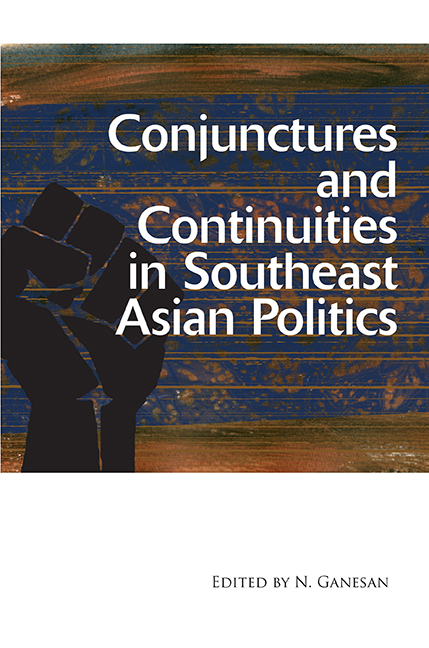Book contents
- Frontmatter
- Contents
- Acknowledgements
- List of Abbreviations
- Contributors
- 1 Conjunctures and Continuities in Southeast Asian Politics
- 2 (Re)Assessing the EDSA “People Power” (1986) as a Critical Conjuncture
- 3 The Road to Doi Moi in 1986: Domestic Dimensions
- 4 The 1988 Uprising in Myanmar: Historical Conjuncture or Praetorian Redux?
- 5 Cambodia's Historical Conjunctures and their Significance
- 6 Changing the Rules: Historical Conjuncture and Transition in Indonesia
- 7 The Resistible Rise of Thaksin Shinawatra: Crisis, Change and the Collapse of Thailand's Democracy
- 8 The March 2008 General Election in Malaysia as a Historical Conjuncture
- 9 Conclusion: Conjunctures and Continuities in Southeast Asia
- Index
7 - The Resistible Rise of Thaksin Shinawatra: Crisis, Change and the Collapse of Thailand's Democracy
Published online by Cambridge University Press: 21 October 2015
- Frontmatter
- Contents
- Acknowledgements
- List of Abbreviations
- Contributors
- 1 Conjunctures and Continuities in Southeast Asian Politics
- 2 (Re)Assessing the EDSA “People Power” (1986) as a Critical Conjuncture
- 3 The Road to Doi Moi in 1986: Domestic Dimensions
- 4 The 1988 Uprising in Myanmar: Historical Conjuncture or Praetorian Redux?
- 5 Cambodia's Historical Conjunctures and their Significance
- 6 Changing the Rules: Historical Conjuncture and Transition in Indonesia
- 7 The Resistible Rise of Thaksin Shinawatra: Crisis, Change and the Collapse of Thailand's Democracy
- 8 The March 2008 General Election in Malaysia as a Historical Conjuncture
- 9 Conclusion: Conjunctures and Continuities in Southeast Asia
- Index
Summary
The military made its move on the evening of 19 September 2006. Ominously foreshadowing that something big was about to go down, Thai television stations abruptly cut out of scheduled programming and played soothing, ready-made slideshows bearing still images of the royal family, at times accompanied by music composed by the King. Shortly thereafter, CNN reported that tanks were rolling through Bangkok in the direction of Government House. The capital city — a megalopolis of ten million people — was taken with derisive ease, in a matter of just minutes. A few tanks and a busload of special forces was all it took for the army to re-take control of the entire country. Prime Minister Thaksin Shinawatra, hours away from speaking to the United Nations General Assembly, feigned outrage and surprise. But he had long been forewarned. Cheered in Bangkok and unencumbered by any hint of active popular opposition, the generals apologized for the “inconvenience” caused, promised to return the country to democracy within a year and, good measure, gave everyone a day off. The edicts that suspended the 1997 Constitution and banned all political activities were accompanied by the instruction that soldiers keep smiling in public.
Thailand is certainly no stranger to coups d'état. The putsch that ousted Thaksin, that is, is only the latest in a string of coups staged since the end of the absolute monarchy in 1932. But things were supposed to be different this time. At the turn of the new millennium, Thailand had been hailed as a success story, a beacon of freedom in a region where more or less oppressive, corrupt dictatorships are the rule. Among other things, the country had pulled through the deep financial crisis that enveloped much of Southeast Asia in 1997 without turning to military strongmen or extra-constitutional rule. The generals, for their part, had no longer seemed to pose much of a threat since the massacre of unarmed demonstrators in May 1992.
- Type
- Chapter
- Information
- Conjunctures and Continuities in Southeast Asian Politics , pp. 151 - 183Publisher: ISEAS–Yusof Ishak InstitutePrint publication year: 2013

